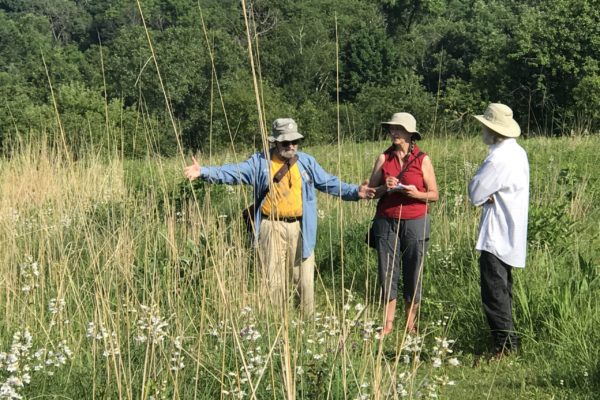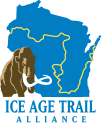By Christi Lee Ehler, Volunteer Writer for the Ice Age Trail Alliance

“The Ice Age National Scenic Trail is where ecology meets people’s experience,” says Kevin Thusius, the Ice Age Trail Alliance’s (IATA) Director of Land Conservation. Managing Ice Age Trail lands for plant and wildlife habitat and managing them for aesthetics go hand-in-hand, because the more biodiverse a landscape is, the more it contains what people go into nature to see, hear, and feel.
A growing number of people, it seems, are particularly drawn to places where they might witness evidence of our ability to repair past environmental damage and create a healthier future for the earth. Ice Age Trail (IAT) segments where there are ongoing, large-scale efforts to rebuild ecological diversity are becoming some of the Trail’s most popular hikes.
[…] the more biodiverse a landscape is, the more it contains what people go into nature to see, hear, and feel.
One of several in the Dane County area is the Table Bluff Segment near Cross Plains. At its northern end, the segment traverses the Holmes Preserve, 73 acres of former farmland the Alliance acquired in 1992. Dane County IATA Chapter members Gary Werner and Tom Wise became involved in restoration work here about 25 years ago and have remained active up to the present.
On a recent hike through the preserve, Kevin, Tom, and Gary highlighted some of the accomplishments here, many earned through trial and error. They also spoke about ways that the endeavors at Holmes are representative of conservation work Trail-wide.
The goal at Holmes is to bring back—as much as possible—the oak savanna ecosystem known to have existed across Southern Wisconsin until the early nineteenth century. The landscape described in historical accounts corresponds with a simplified definition for savanna: prairie beneath sporadic trees. Recreating this landscape provides hikers with a markedly different experience than the forested IAT segments of Northern Wisconsin. In a savanna, long scenic views remain open in all seasons.
Along the Table Bluff Segment, the geology of the surrounding Driftless Area is a constant presence. Work at Holmes combines elements of prairie and woodland conservation. Scant remnants of Southern Wisconsin’s original vegetation still survive here and at several nearby locations—mostly on the sides of steep moraines that escaped plowing and overgrazing. These remnants helped inform decisions about which native species to reintroduce.
The goal at Holmes is to bring back — as much as possible — the oak savanna ecosystem known to have existed across Southern Wisconsin until the early nineteenth century.
One of the first things Gary, Tom, and fellow volunteers did here was plant dozens of burr oak seedlings. Now 12 feet or taller, the oaks stand surrounded by native prairie grasses and flowering plants. This sunny morning in late June, the prairie is in a white phase: White Penstemon, White Baptisia, and yarrow are blooming. Native sunflowers add a touch of bright yellow.
During the years leading up to the first prairie seeding in 2000, volunteers concentrated on clearing the land of undesirable plant species: aggressive non-natives like buckthorn and honeysuckle, plus native species that don’t belong in this ecosystem, such as red cedar. As we make our way along the mown trail, Gary spies a few curly dock plants and out of habit, plucks them up, roots and all.
“Persistence pays,” he says. Each year brings a noticeable reduction of invasive herbaceous plants as their seedbanks in the soil decrease. Consistently cutting woody plants in late summer has significantly weakened their regrowth in subsequent years. Brush-cutting, grubbing, mowing, and spot-treating with herbicide all play a vital role in controlling unwanted vegetation. Nevertheless, Tom and Gary emphasize that none of these strategies can match the effectiveness of fire.

Fire not only suppresses plants that don’t belong in the savanna ecosystem, it can invigorate those that do. Having developed in the presence of periodic fire, Southern Wisconsin’s native plant communities—and even some insects—are adapted to it. And when used over and over in one area, fire becomes more efficient. At the Holmes Preserve, repeatedly running fire from the prairie into the small oak-hickory woodland on the property will eventually create a more gradual transition between the two areas.
Fire-intolerant cherry and box elder ultimately won’t survive, but flowering plants like Shooting Star and Dutchman’s Breeches will thrive in their absence. Just inside the woods, there are signs that the land’s own natural processes are beginning to help rebuild themselves. Tom identifies nearly a dozen species of native herbaceous plants at the foot of one white oak tree. He gestures toward a patch of White Penstemon blooming in dappled shade a few yards away. “The wind planted that,” he says. “We didn’t.”
But a recreated ecosystem will always require some level of help from humans to maintain it. In that sense, Kevin likens restored landscapes along the IAT to a “living museum.” Most ecosystems are too complex to replicate as they originally existed, so the best we can do is curate them to reflect our current level of understanding of how they function.
Even so, restoration work allows Trail users to glimpse a relatively accurate portrayal of the land’s history and the life that once flourished there. It may be impossible to bring back the large herbivores that roamed Wisconsin’s prairies for centuries, but land managers continually apply new knowledge, as it becomes available, to facilitate relationships among organisms that are present. In the face of climate change, Kevin says, the key strategy is managing for overall resiliency.
Just inside the woods, there are signs that the land’s own natural processes are beginning to help rebuild themselves.
A thousand-mile footpath for hikers also serves as a thousand-mile corridor for wildlife. Restoration work along the IAT is helping rejoin habitat fragments, in large part due to the Alliance’s many positive relationships with a wide variety of organizations responsible for managing lands adjacent to the Trail. Within and beyond the IAT stewardship zone, a haven is being created for native birds, mammals, reptiles, amphibians, and pollinators increasingly vulnerable to extinction through habitat loss.
Midway through the hike, a bird song catches Kevin’s ear — Henslow’s sparrow. It’s a species listed as Threatened in Wisconsin that prefers open grasslands. He points out a small, inconspicuous brown bird flitting among the prairie grasses a few feet off the trail. “Hearing it here during breeding season is significant,” he says. “I’m excited.”
About the Author
Christi enjoys spending as much time as possible outdoors. While hiking in a county park one autumn day, an encounter with a group of volunteers engaged in trail stewardship prompted an epiphany that led her to join a Mobile Skills Crew project in 2015. That event marked the beginning of a growing passion for trail building with the IATA. Writing about trail work is icing on the cake.
This article first appeared in our Fall – Winter 2019 Mammoth Tales Publication.

